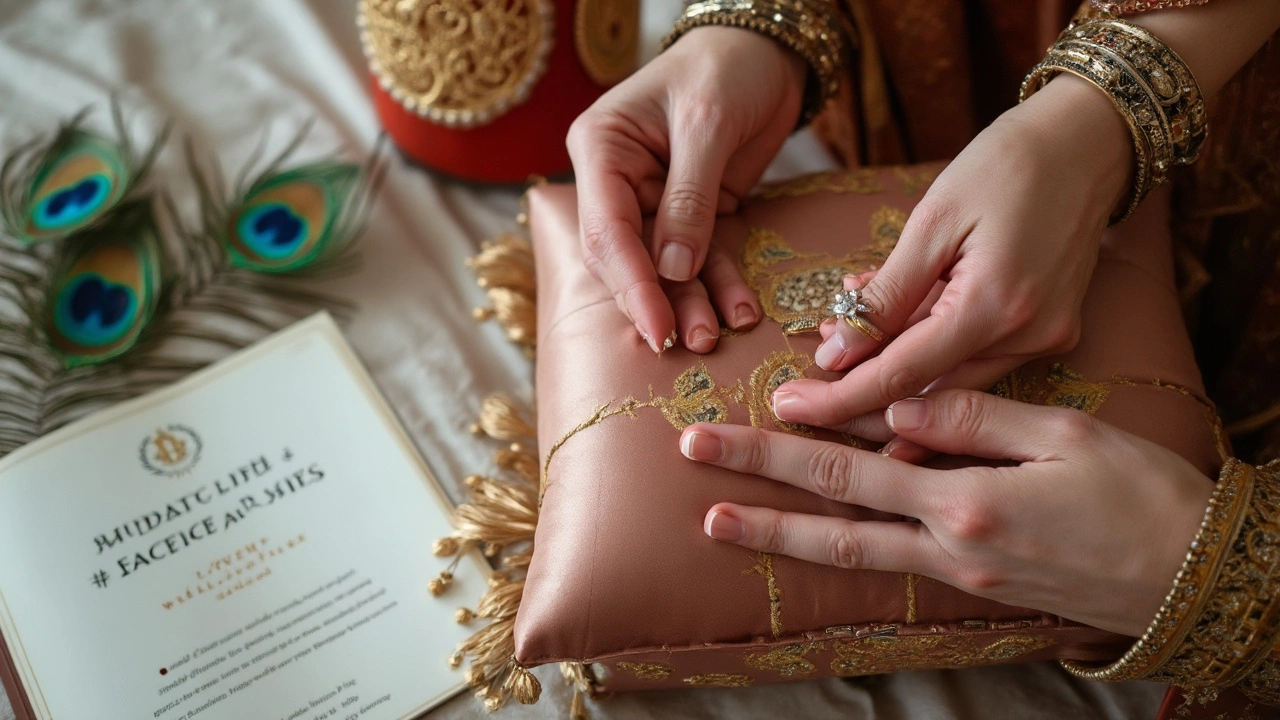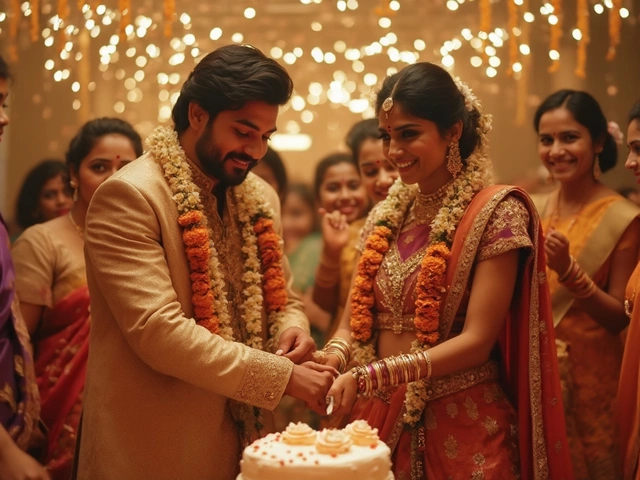
So you’re standing in front of the mirror, gorgeous dress on, and you suddenly realize—what do you actually do with your engagement ring while you're getting married? You’ve probably seen brides slide their rings onto a different finger or hand, but is there a real reason for this?
Turns out, there’s a mix of tradition and pure practicality here. The wedding band is supposed to go on first, sitting closer to your heart (yup, that’s an old romantic custom that’s stuck around). That means your engagement ring ends up on top after the ceremony is done.
But there's more to it than just history. Handing over your left ring finger ensures the officiant or partner can slide the band on smoothly, without your engagement ring getting in the way. Imagine fumbling with stuck rings in the middle of ‘I do’—not exactly dream wedding vibes!
- Where the Tradition Started
- Practical Reasons to Take Off Your Ring
- Common Ways Brides Handle Their Rings
- Showing Off Both Rings—What Looks Best
- Expert Tips to Keep Your Rings Safe
Where the Tradition Started
The idea of taking off your engagement ring during the wedding isn’t some random new rule. It goes way back—like ancient Rome and Egypt back. Back then, people believed the fourth finger on the left hand had a vein that led straight to the heart. They literally called it the “vein of love.” That’s why both your engagement and wedding rings usually end up on that finger.
Fast forward a few centuries, and people in Europe started putting the wedding band on first during the ceremony. The wedding band, seen as the real symbol of marriage, was supposed to sit closest to the heart—stacking it under the engagement ring after the ‘I dos’ ended. This is why, for the actual ceremony, you’ll see lots of brides move their engagement ring to their right hand or just take it off completely.
Historians say this tradition got more popular in Western countries during the Victorian era, when big, sparkly engagement rings really took off. Jewelers at the time were all about making rules around ring etiquette, especially as more people could afford both rings.
And it’s not just an old-school thing. A 2022 survey by The Knot found that 69% of brides in the US followed this tradition in some way—putting the wedding band on first, then moving the engagement ring back after the ceremony.
So if you’re standing at the altar and your left ring finger feels a little bare, just remember: you’re following a tradition that’s literally thousands of years old—and it’s all about showing your new band off in the right spot.
Practical Reasons to Take Off Your Ring
This isn’t just about wedding superstitions or fancy customs—there are real, straightforward reasons why people take off their engagement rings before the ceremony. One big thing: the wedding ring is usually worn on the left ring finger, and most folks want to make sure that band sits closest to the heart. If you leave your engagement ring on, it can block the spot where the wedding band needs to go, which can make things awkward at the altar.
Then there’s the fit problem. For lots of brides, wearing both rings together for the first time can make things feel extra tight. If you’re nervous or your hands swell (which totally happens thanks to nerves or summer heat), those rings may not slide on smoothly. Moving your engagement ring to your right hand keeps things simple—and way less stressful—since your left ring finger is wide open and ready for that moment.
Don’t forget about the photos. Your photographer will definitely want a clear shot of your new wedding ring slipping onto your finger. Having your engagement ring in the way looks cluttered, and honestly, it hides the star of the show—the new band. That’s why a lot of wedding planners suggest taking off engagement rings, at least until after the ceremony.
Here are a few quick-fire reasons for moving your engagement ring off your left hand before the big "I do" moment:
- Keeps the ring finger open for the main event: your wedding band.
- Prevents confusion and awkward shuffling at the altar.
- Makes for better, cleaner photos during the exchange.
- Reduces risk of dropping or fumbling rings because of tightness.
According to the Knot’s 2023 Wedding Study, about 71% of couples stick to the tradition of wearing both rings on the left hand after the ceremony. Most brides either move their engagement ring to their right hand temporarily or leave it off entirely just until pictures are done.

Common Ways Brides Handle Their Rings
When it comes to the engagement ring during the wedding ceremony, there’s really no one-size-fits-all rule. Most brides want the wedding band to go on first, so they find a quick fix for their engagement bling until the vows are done. Here are some popular ways brides handle it:
- Switching Hands: Probably the most common option. Move your engagement ring to your right hand before you walk down the aisle. After the ceremony, you can pop it back onto your left ring finger—on top of your shiny new band.
- Leaving It Off: Some brides leave their engagement ring at home or safe with a trusted friend. This is the safest option if you’re worried about dropping it during all the excitement. Just don’t forget where you put it!
- Wearing It on a Necklace: For sentimental types, slipping the ring onto a chain and wearing it as a necklace keeps it close without interfering with the big ring exchange. Bonus: it makes a cute accessory.
- Keeping It in a Secure Spot: A pocket, a clutch bag, or a ring box held by someone you trust—all are practical spots for safekeeping.
A 2023 survey from The Knot found that about 65% of brides switched their engagement ring to their right hand before the wedding ceremony. Another 20% left it with a family member or in a safe place, while less than 10% wore it on a necklace or carried it in their bridal bag.
| Ring Handling Method | % of Brides (2023) |
|---|---|
| Moved to right hand | 65% |
| Left with trusted person/safe spot | 20% |
| Wore as necklace | 7% |
| Carried in bag | 4% |
| Other | 4% |
Whichever way you pick, double-check your rings are safe before the ceremony starts. The last thing you want is a frantic search when you should be celebrating!
Showing Off Both Rings—What Looks Best
Okay, so you've swapped your engagement ring back after the ceremony. Now what? Most people want both their wedding rings and engagement rings to look awesome together because, honestly, you’ll be rocking these every day. Let’s talk about real, practical ways to pull this off.
The classic order—wedding band first, then engagement ring stacked on top—has stuck around because it simply looks balanced. The rings are right next to each other and easy to show off in pictures. Jewelers actually design a lot of rings as “bridal sets,” made to fit together perfectly, so you don’t have gaps or awkward wobbles.
If your rings don’t match shape-wise, it helps to get a contoured or notched wedding band. Some brides even get their rings soldered together after the ceremony for a seamless look. That means no more spinning rings or fussing with the order—it’s all just one piece, and you can forget about losing one during heavy workouts or gardening.
Curious how others do it? Recent wedding trends show about 71% of brides keep their rings stacked on the same finger, just like tradition suggests. But there’s no actual rule book—some wear their bands on different hands or even alternate days for different rings.
| Popular Ways to Wear Both Rings | Percentage of Brides |
|---|---|
| Stacked on the left hand (band first) | 71% |
| Engagement ring on right hand, band on left | 19% |
| Soldered together as one ring | 10% |
Photos are a big deal, so here’s a tip: right after the ceremony, give your hands a quick check. Sometimes nerves and heat can make your fingers swell, making the stack look tighter. Hydrate, and if you need to, take a few minutes to let your hands relax. Clean rings take better photos, so a quick wipe before your photographer zooms in can make a difference.
No matter which style you pick, what matters most is that you feel comfortable and happy every time you look down at your hand. There’s zero shame in choosing the look you like best, whether it’s super traditional or a style that makes your rings stand out on their own.

Expert Tips to Keep Your Rings Safe
No one wants a lost engagement ring or a scratched-up wedding ring on their wedding day. The number one tip from jewelers? Plan ahead before the ceremony so your rings stay safe and stunning.
If you’ll be removing your engagement ring for the ceremony, stash it somewhere secure—like a ring box with a trusted person. This means your ring isn’t rolling around in a random purse or getting left behind in a bathroom. If you feel weird not wearing your ring, switch it to your right hand, but know that fingers can puff up if you’re nervous or it’s hot, so don’t force it.
- Ask your maid of honor or a parent to hang onto your ring in a small, sealable pouch or ring box.
- If you're worried about forgetfulness, have a “ring transfer” check-in built into your getting ready routine.
- Traveling to your venue? Keep your rings in a zippered pouch that can attach inside your bag, not just tossed loosely in a makeup pouch.
- Never set your rings down on a sink ledge or anywhere near a drain—wedding days are hectic and things get lost in a heartbeat.
- If your rings feel loose, hit up your jeweler for inexpensive spacers a week before (they’re lifesavers for a better fit and less stress).
Gemological Institute of America (GIA) recommends regular cleaning and checking the settings before the big day. A little maintenance means your wedding rings are sparkling in photos and you don’t risk a loose stone.
Here’s a quick breakdown of safe ring handling tips brides actually use:
| Situation | Best Practice |
|---|---|
| During ceremony | Wear on right hand or give to a trusted person |
| Getting ready | Keep in ring box, not loose in purse |
| Photo sessions | Only handle with clean, dry hands |
| After ceremony | Stack wedding band first, then engagement ring |
Bottom line: Protecting your engagement ring and wedding ring is part of being prepared for your wedding day. A little planning upfront means less stress and no panicky “where’s my ring?” moments later.



Comments
Post Comment